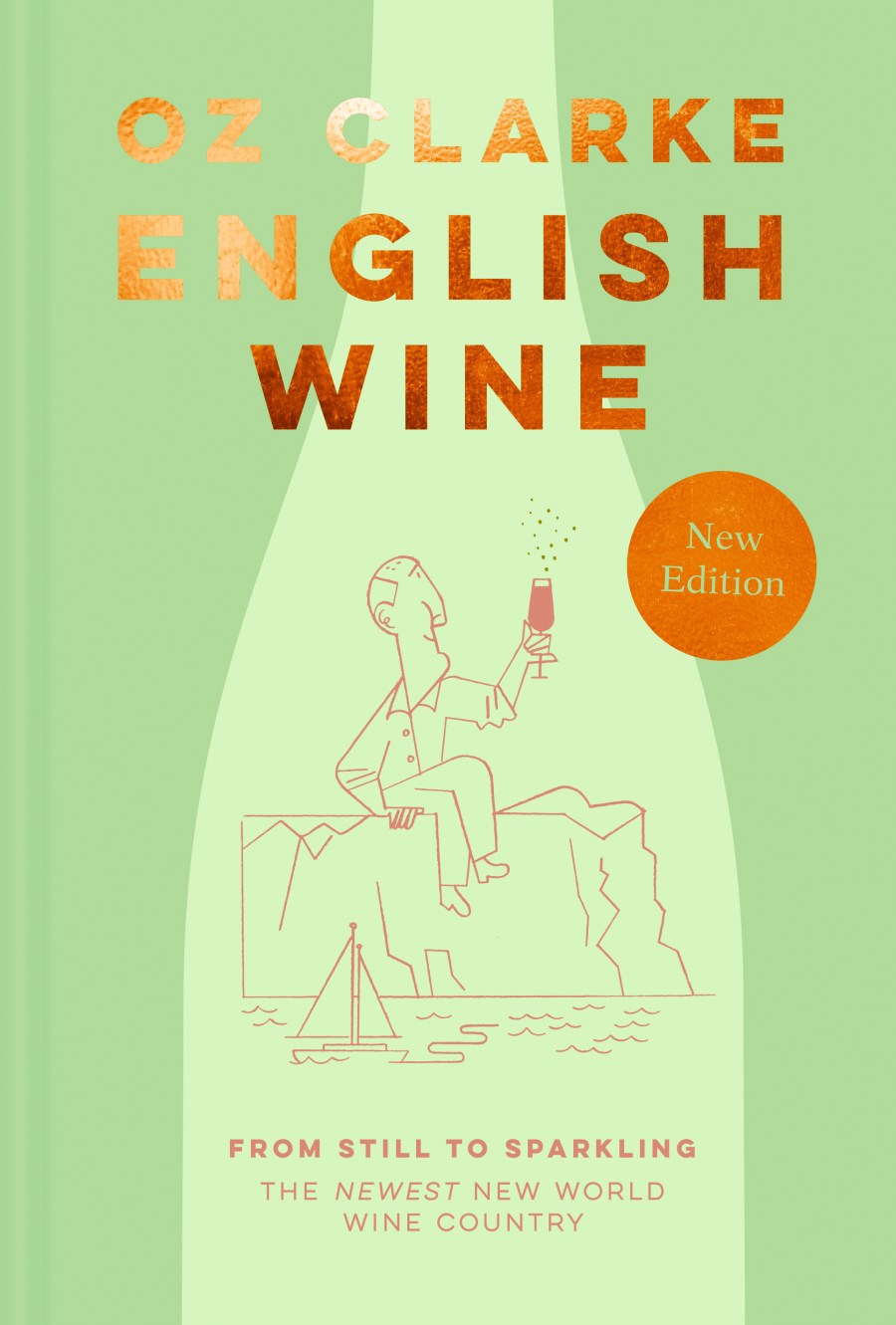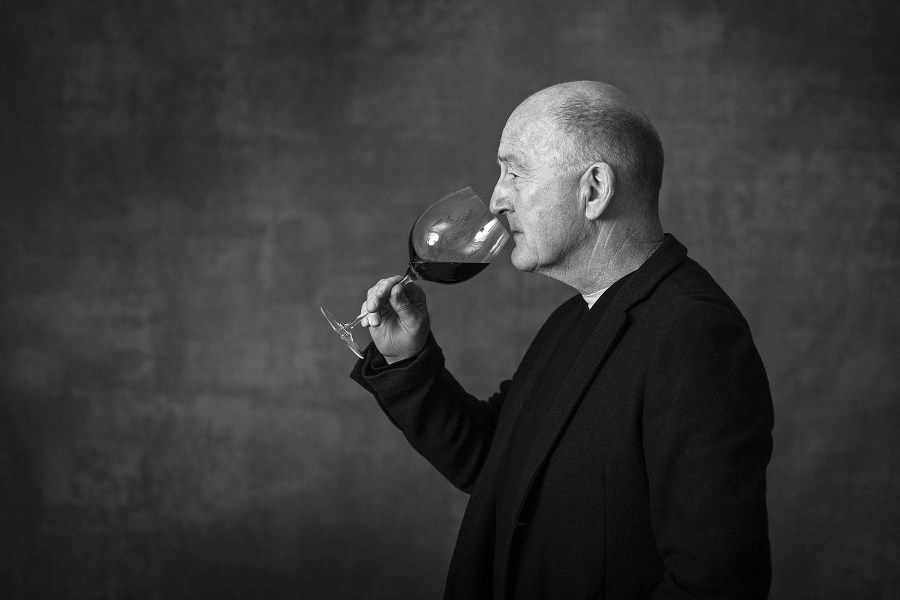This month Vineyard magazine chatted with Oz Clarke about the journey of English and Welsh wine together with the release of the updated version of his book entitled English Wine From Still to Sparkling. The Newest New World Wine Country.
The updated version of this book with a beautiful pastel green front cover giving the immediate mental image of restful countryside has been released just two years after the first edition and takes an in depth look at the vineyards of England and Wales.
Oz Clarke holds English and Welsh wine in high esteem and this is evident from the fact that he does not like the use of the term ‘industry’ when referencing production within our shores. “The term still subconsciously has an industrial connection,” said Oz. This conjures a mental picture that is a far cry from “the charming and attractive transformation of the landscape,” that is also producing world beating wines. In addition it implies no reflection of the way vineyard managers, winemakers and consultants are working together to support each other and here Oz uses the lovely example of Chapel Down who passed the benefit of their expertise to their neighbours and colleagues when downy mildew became a problem in the growing season a few years ago. I could only agree with Oz when he said: “This is not a corporate industry but a community;” the idea makes me smile.
On a rather more controversial note Oz said: “I don’t have a problem with the terms English Sparkling or Welsh Sparkling as the names have been well accepted overseas. Markets such as Scandinavia appreciate and understand what they are buying when they see this term.” To protect the top end of the market and maintain the prestige of the traditional method ensuring that other methods of production do not degrade the perception of quality Oz suggested that if “vineyards work together, with technical committees and vineyard groups offering each other help and advice, a system of self regulation should then naturally develop.
“In this way we can avoid the danger of over regulation. One of the exciting things about winemaking in England and Wales is that talented men and women who have travelled all over the world with different visions of flavour and skills have the freedom to make great wine but they do not have to follow set rules. There is no such thing as ‘should’ when considering the taste of English and Welsh wine,” he added.
“Even before the first book went to press it was apparent that there would be a need for the book to be followed up,” explained Oz. Looking at some of the graphics from the book it becomes clear just how fast the English and Welsh wine scene is changing. One excellent graphic uses wine bottles as a pictogram showing how production has increased over time. The wine bottle for 2018 was completely full with 13.2m bottles produced and proving that, despite seasonal variations in production, figures are only going to increase. In both 2019 and 2020 over 10m bottles were produced. Oz went on to say: “To keep the graphic going to 2022 it would need a new bottle size.” This dramatically illustrates why this updated version of the book became necessary (a copy of this graphic is found on the next page).
Each vineyard featured in the book has a fact sheet containing information about the possibility of visiting that vineyard, any tours they may offer, how to buy the wine and personal recommendations from Oz about the wines. “Every entry starts with an invitation to the reader,” he said. The idea of localism was something that developed during the pandemic and we all had our difficulties. Oz recalled: “Since there were no tastings I had to pull wines from under the stairs to keep my palate in training,” but when it was possible to get out and about again “people were sufficiently excited about visiting their local vineyards. The public have certainly embraced the opportunities to get into a vineyard walk about and enjoy the whole experience,” he added. “It is possible with a good visitor centre not to need your own winery,” he concluded. This interest has been reflected across the on-trade. Talking to people about the demand for English and Welsh wines amongst the on-trade Oz has found that the supply cannot really keep up but happily there are many new vines coming on stream with every passing year.
Evident in the book is the proliferation of many smaller but prestigious vineyards. In a comparison with the first edition the chapter overview for just the county of Kent has six extra vineyards or wineries. East Anglia is another county that has seen significant increases in vines planted and the latest edition of the book reflects this including six vineyards, one of which is Danbury Ridge, whose objective as the book so neatly describes “is to make world class still wines – from Chardonnay and Pinot Noir.”
Using an analogy that is perfect for our maritime climate Oz said: “The rising tide lifts all boats, when more recognition comes to a greater number of smaller producers the greater benefit there is to everyone, the large and the small.”
That the ‘Newest New World Wine Country’ has caught the attention of winemakers over the pond is evident from the inclusion of Domaine Evremond in this latest edition of the book. “The French are not very good at sharing respect,” said Oz and yet French Champagne houses are now setting up shop not just in Kent but also in Hampshire. “I think we can allow ourselves to recognise how well we are doing,” he said. Reassuringly he added: “The wines made here by French Champagne houses will be different from those of their neighbours.”
PiWi varieties feature far more heavily in the updated book than the previous edition. Under the county of West Sussex, Artelium make an interesting addition to the updated book which states “the new plantings in 2022 are not what you would expect – Souvignier Gris, Sauvignac, Pinotin, Cabernet Noir, Divico.” Oz said: “They decided it was no good planting experimental plots someone has got to plant a lot; well done them.” To contextualise the PiWi plantings “Champagne now have an accepted PiWi variety,” Oz added. “Innovative British people are using their time effort and money to develop these varieties, but winemakers have also found ways to make other varieties work. Rondo is a brute of a grape but when treated gently it has been making nice wine all around the UK,” he added.
It is clear from the book and from our conversation that Oz believes that climate is at the very centre of everything wine. Speaking about a visit to Gwinllan Conwy vineyard he said: “They explained why the vineyard was so close to the Victorian tourist resort of Llandudno. These places were built for winter recreation areas due to the mild climate; that mild climate is also perfect for vines.”
Oz went on to give lots of examples of micro climates all over the UK. Areas where he described the local conditions as “thrilling.” One such example is, the scientifically significant, Dungeness, the only classified desert in the UK “and you can see Boot Hill Vineyard in the distance,” he added. The point that Oz makes is that these vineyards are not found in these areas by accident, they have been researched thoroughly for site suitability. Quoting the work of Dr Alistair Nesbitt he points to the exciting possibilities that have been highlighted as a direct result of science. “Climate change has a massive part to play in the expansion of English and Welsh wine but the work of scientists and the increasing number of wine consultants must also be recognised,” he said. There can be no doubt that climate change brings with it much uncertainty; rising temperatures and extreme weather events will become more problematic the world over.
There are already significant changes that can be seen in viticulture in the UK. “We talk about vine growing in counties that would have been impossible only a few years ago,” added OZ. He thinks places such as the Crouch Valley, the Vale of Clwyd and the county of Suffolk are some of the areas just waiting for a vineyard explosion.
The new edition of the book includes an interesting section on wine in cans. The Uncommon can be found on Virgin Atlantic and on the shelf in Selfridges showing that this alternative format already has prestige but “with a reduction in carbon footprint over glass bottles canned wine has got a significant future,” said Oz. “It is a product that fills an exact market need and portrays itself exactly as it is,” he added. One of the remarkable aspects of English wine in cans is that the quality keeps getting better. “Every year I try one, it is better than the last,” said Oz.
Oz Clarke has chaired the tasting for the WineGB awards for many years. The wines are tasted blind identified only by a number but what people might not know is that Oz writes to each of the entrants that have not received an award with both praise and constructive comments. This personal touch even to the anonymous vineyards behind those bottles shows his dedication to the advancement of English and Welsh wine from ground to glass.
Right at the end of our conversation Oz let slip that his next project involves audiobooks. His prestigious and extensive acting career will assist him as he brings his books to life with a passion and sophisticated style that will present an irresistible invitation into the world of wine.





